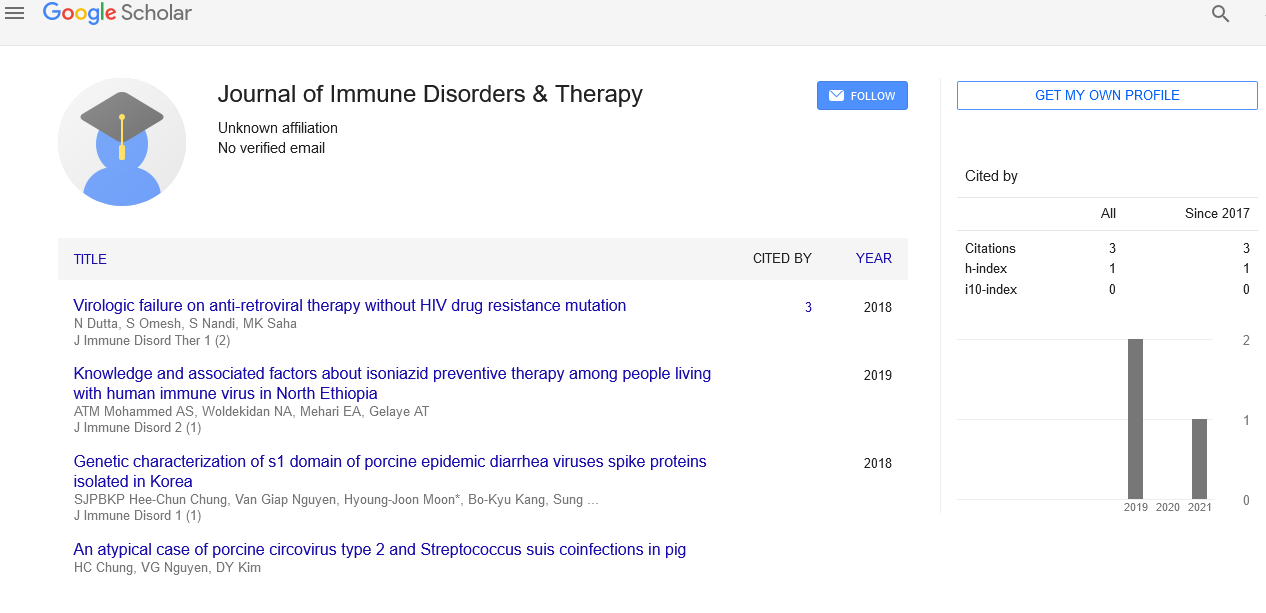Editorial note on Cancer Immunity and Immunotherapy
Received: 05-Aug-2021 Accepted Date: Aug 15, 2021; Published: 25-Aug-2021
This open-access article is distributed under the terms of the Creative Commons Attribution Non-Commercial License (CC BY-NC) (http://creativecommons.org/licenses/by-nc/4.0/), which permits reuse, distribution and reproduction of the article, provided that the original work is properly cited and the reuse is restricted to noncommercial purposes. For commercial reuse, contact reprints@pulsus.com
Editorial
The Journal of Immune Disorders & Therapy is an open access peer – reviewed journal which includes a wide range of fields like Autoimmune diseases, Immunology, Rheumatology, Dermatology, Endocrinology, Molecular genetics, Cell biology etc. The journal creates a platform for the authors to publish a relatively reliable source of information on recent immunotherapies through research articles, review articles, and clinical studies. It emphasize on free online access to the researchers worldwide. It’s an on-going theoretical & practical based publication that proffers novel scientific research on the adept practical approaches related to immune disorders & therapy.
Cancer
Malignancy is a condition where a few cells in the body outgrow control and spread to different pieces of the body. Disease can start basically anyplace in the trillions of cells that make up the human body. Human cells typically grow and duplicate (through a cycle known as cell division) to create new cells on a case by case basis by the body. Cells bite the dust as they become old or harmed, and new cells supplant them. This arranged interaction can at times separate, bringing about atypical or harmed cells developing and increasing when they shouldn’t. Cancers, which are masses of tissue, can develop from these cells. Growths might be threatening. Harmful cancers can contaminate neighboring tissues and spread to different pieces of the body.
Types of Cancer
There are more than 100 unique types of cancer. Malignancies are regularly called after the organs or tissues wherein they create. Cellular breakdown in the lungs, for instance, starts in the lungs, while mind malignant growth starts in the cerebrum. Malignancies can likewise be characterized dependent on the sort of cell that caused them, for example, epithelial or squamous cells.
Carcinoma
The most predominant sort of malignant growth is carcinoma. Epithelial cells, which cover within and outside surfaces of the body, are liable for their development. Various sorts of epithelial cells exist, and when seen under a magnifying instrument, they regularly have a segment like structure.
Sarcoma
Sarcomas are malignancies that create in the delicate tissues of the body, like muscle, fat, veins, lymph vessels, and sinewy tissue (like ligaments and tendons). The most incessant bone disease is osteosarcoma. Leiomyosarcoma, Kaposi sarcoma, dangerous stringy histiocytoma, liposarcoma, and dermatofibrosarcoma protuberans are the most continuous delicate tissue sarcomas.
Leukemia
Leukemias are malignant growths that beginning in the bone marrow’s blood-framing tissue. Strong growths are not framed by these diseases. In the blood and bone marrow, gigantic quantities of unusual white platelets (leukemia cells and leukemic impact cells) create up, crushing out typical platelets. The body’s capacity to get oxygen to its tissues, control dying, and battle diseases would all be able to be hampered by an absence of standard platelets.
Immunotherapy to treat cancer
Immunotherapy is a disease therapy that helps your invulnerable framework’s capacity to battle malignancy. Your invulnerable framework supports the fight against contaminations and different issues. It is comprised of white platelets just as lymphatic organs and tissues. Immunotherapy is an organic treatment. Natural treatment is a strategy for malignancy treatment that utilization compounds got from live living beings.
Acknowledgment
The authors are grateful to the journal editor and the anonymous reviewers for their helpful comments and suggestions.
Declaration of Conflicting Interests
The authors declared no potential conflicts of interest for the research, authorship, and/or publication of this article.





